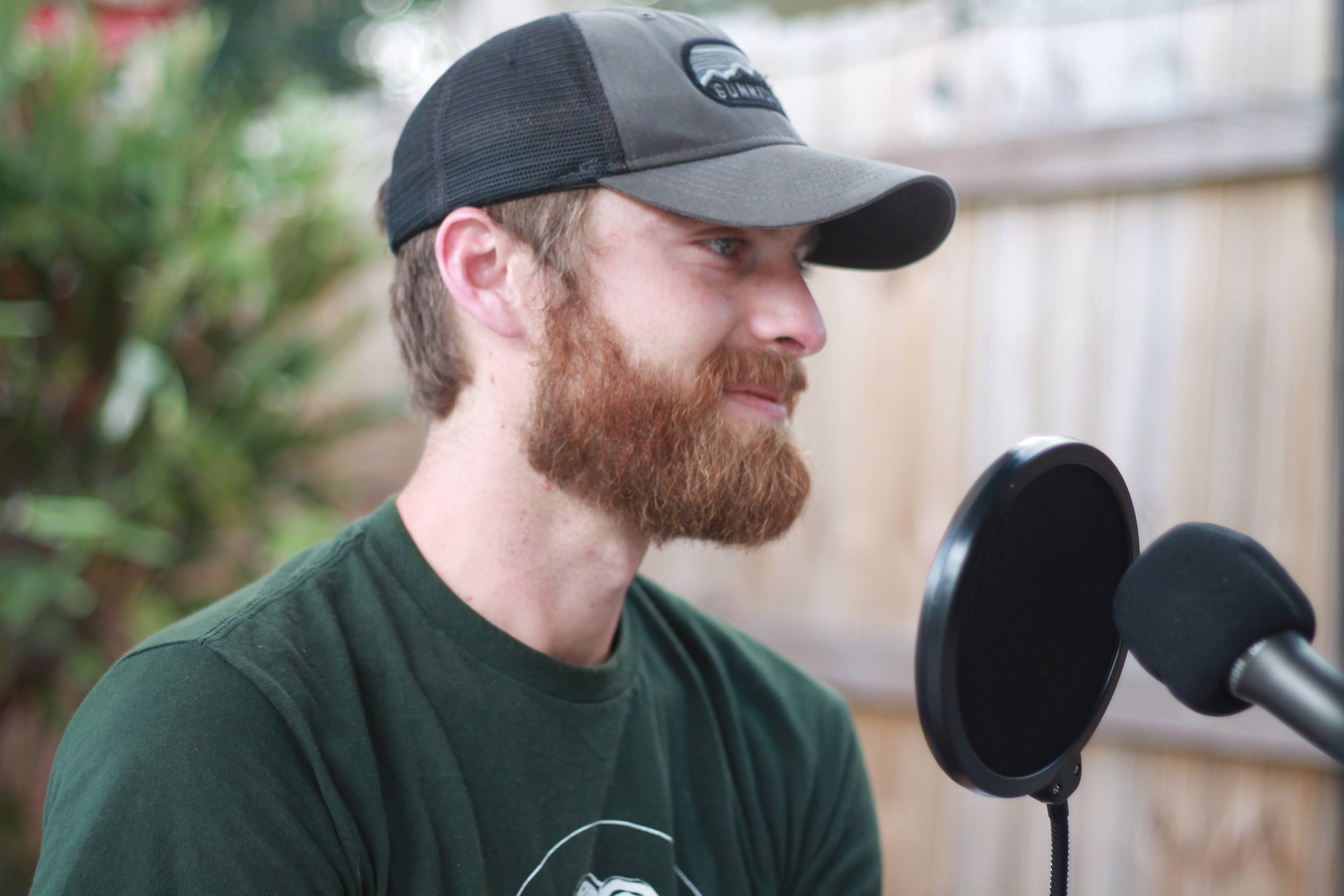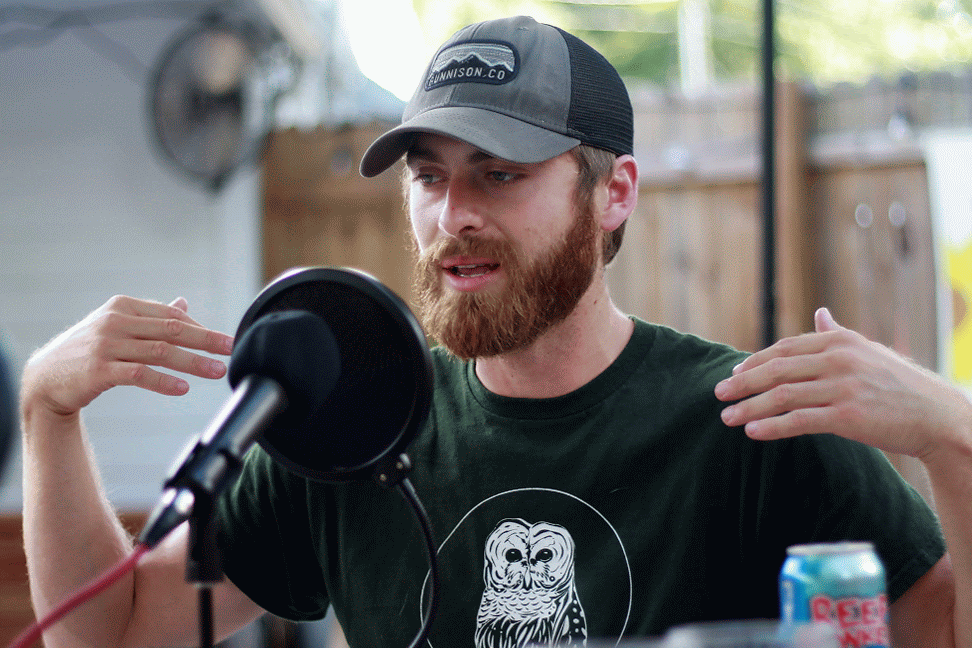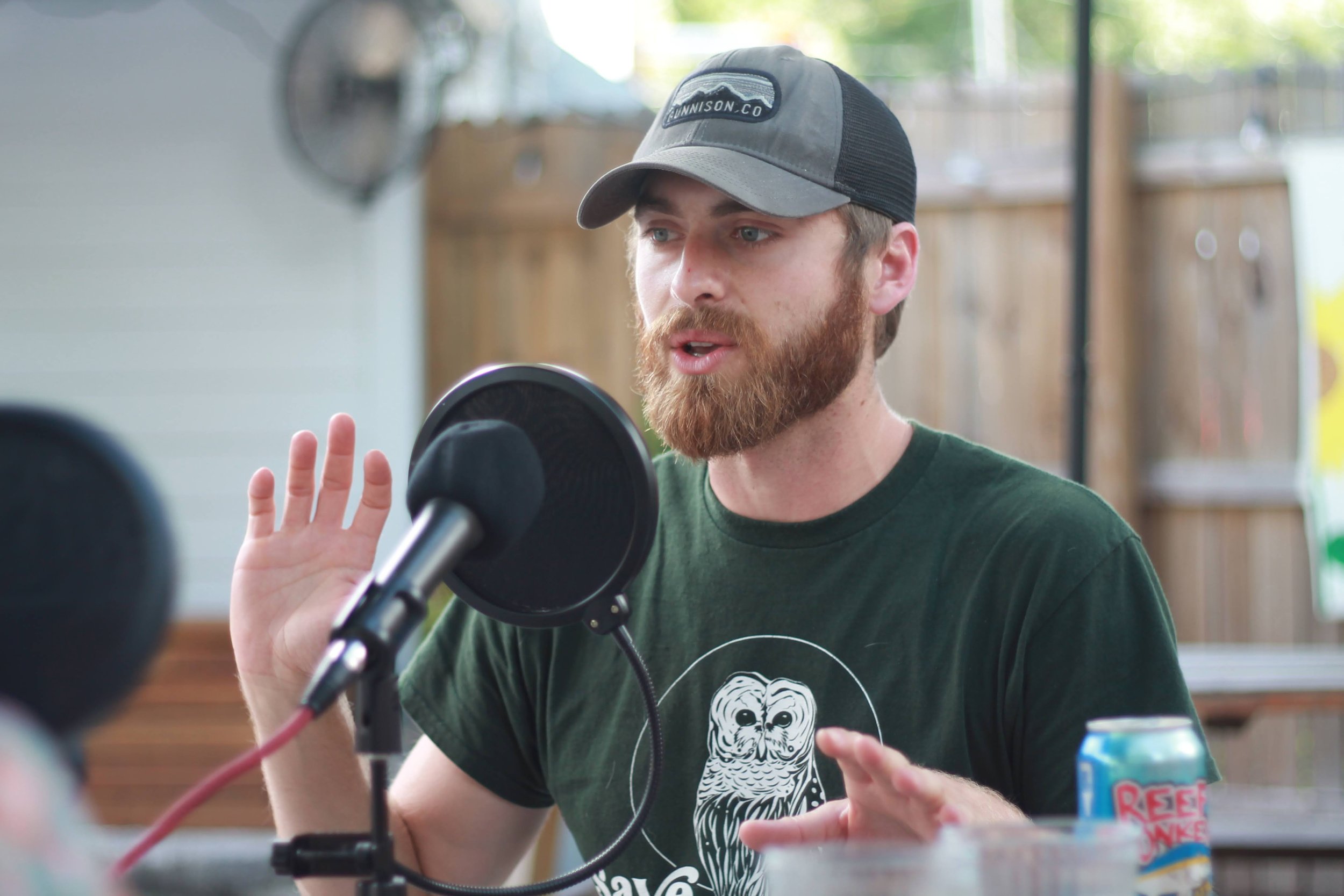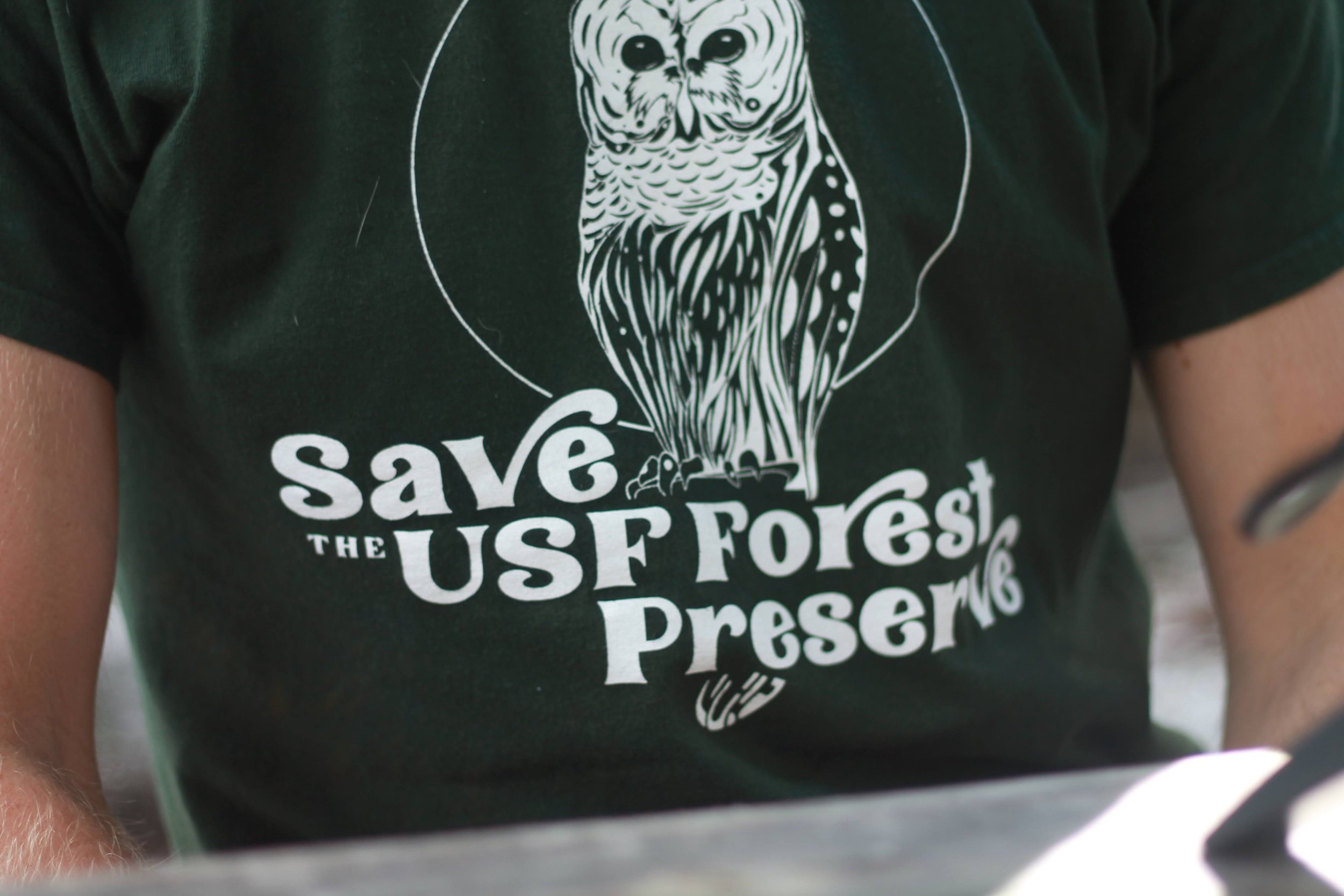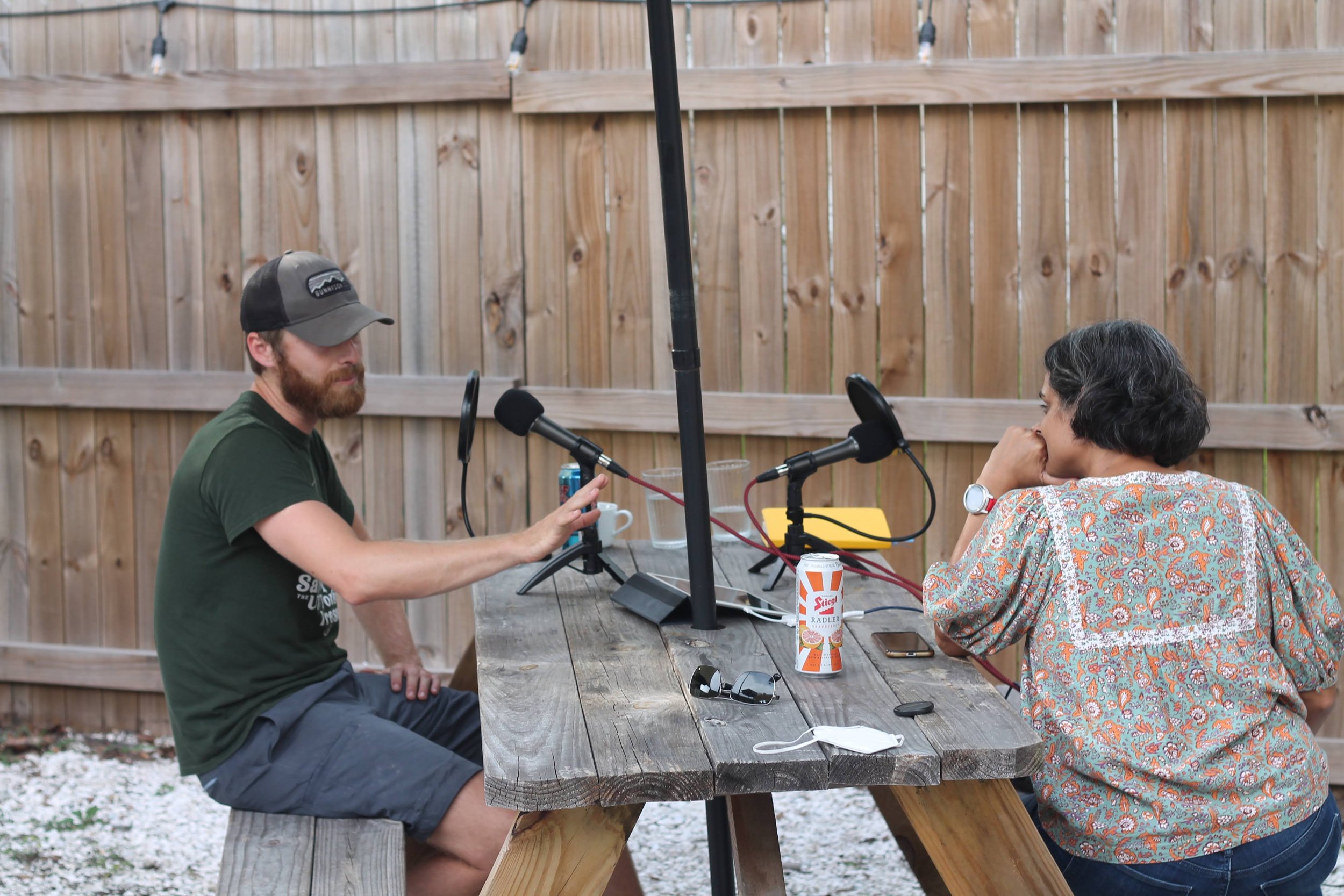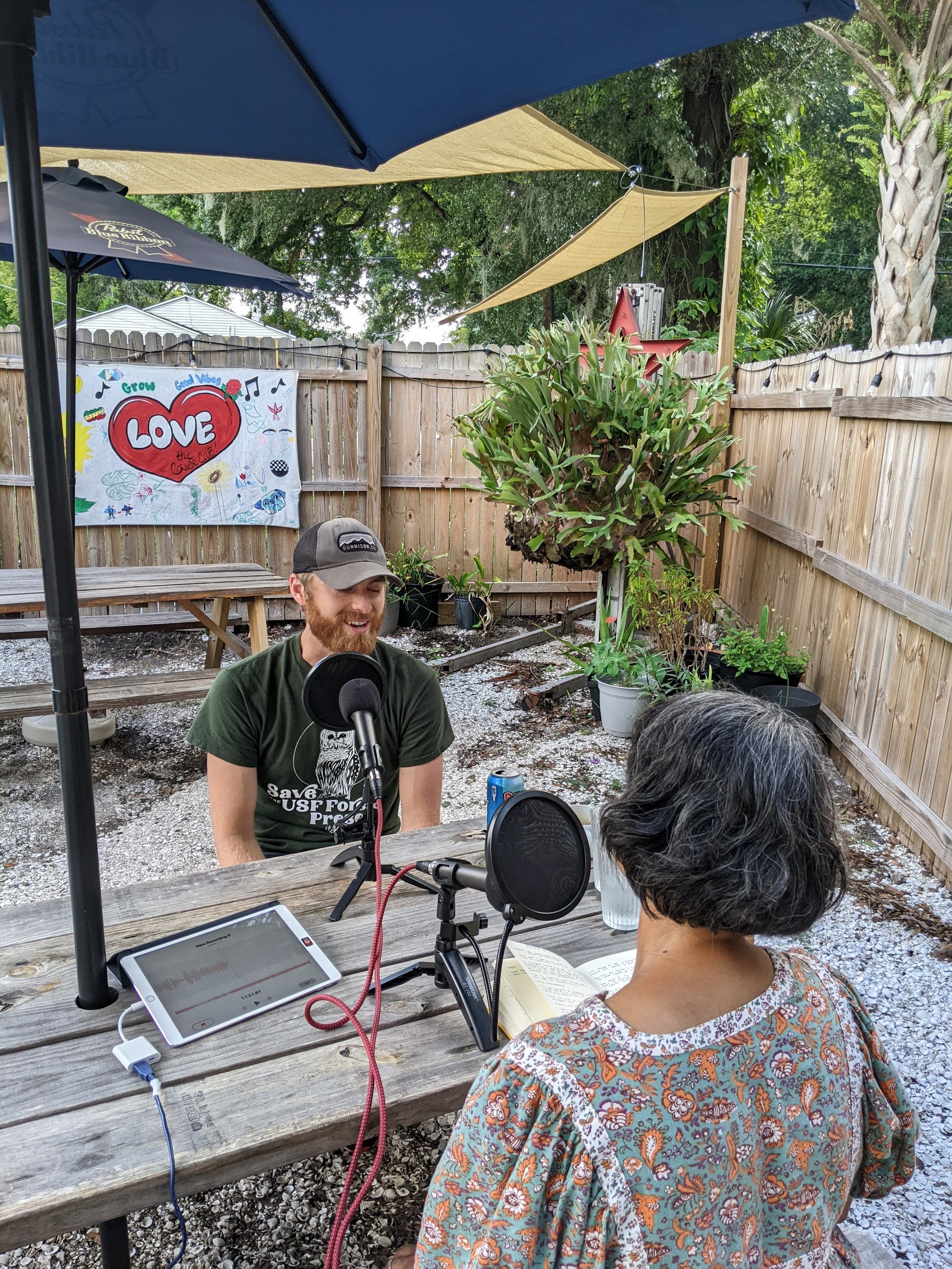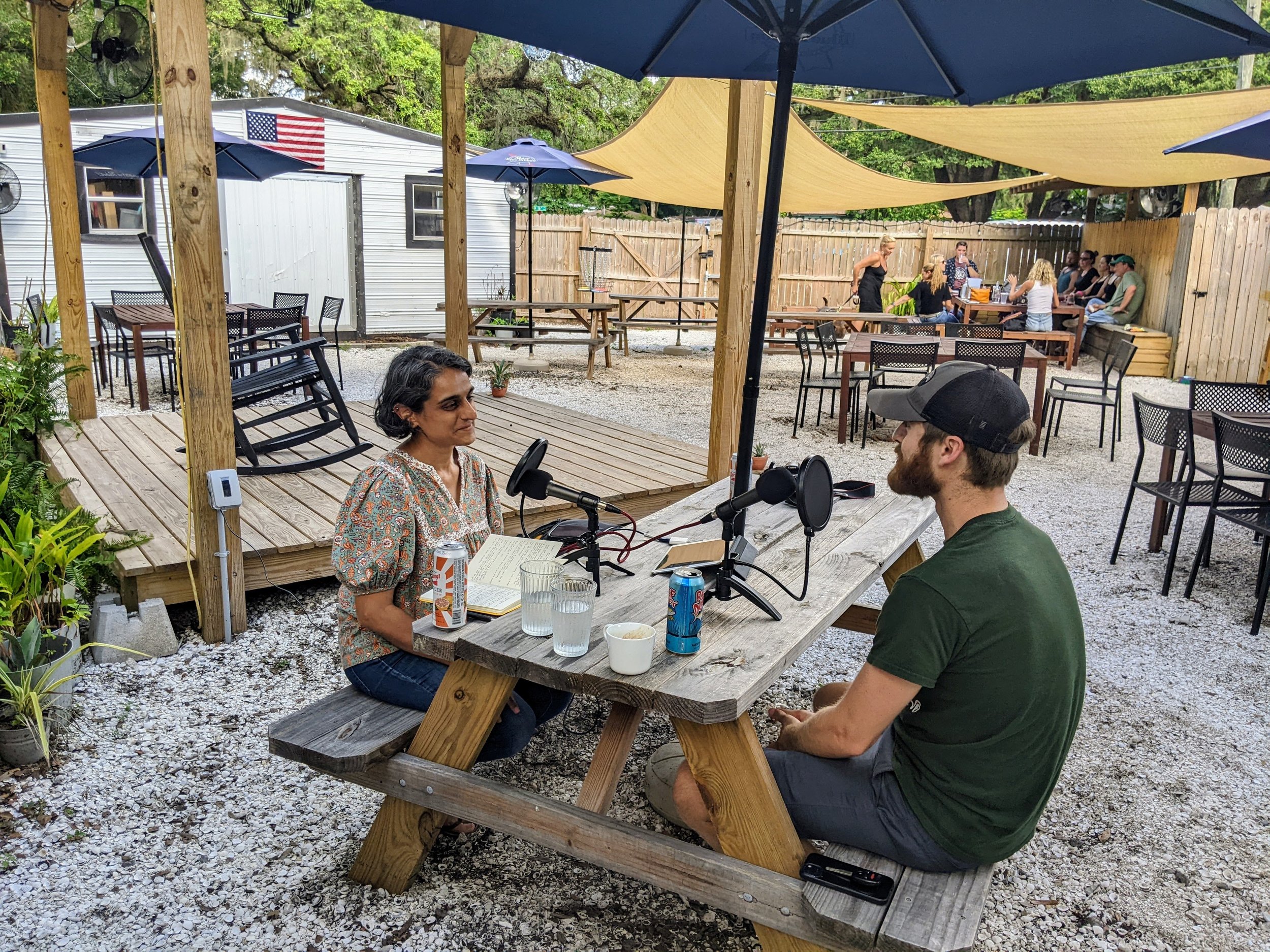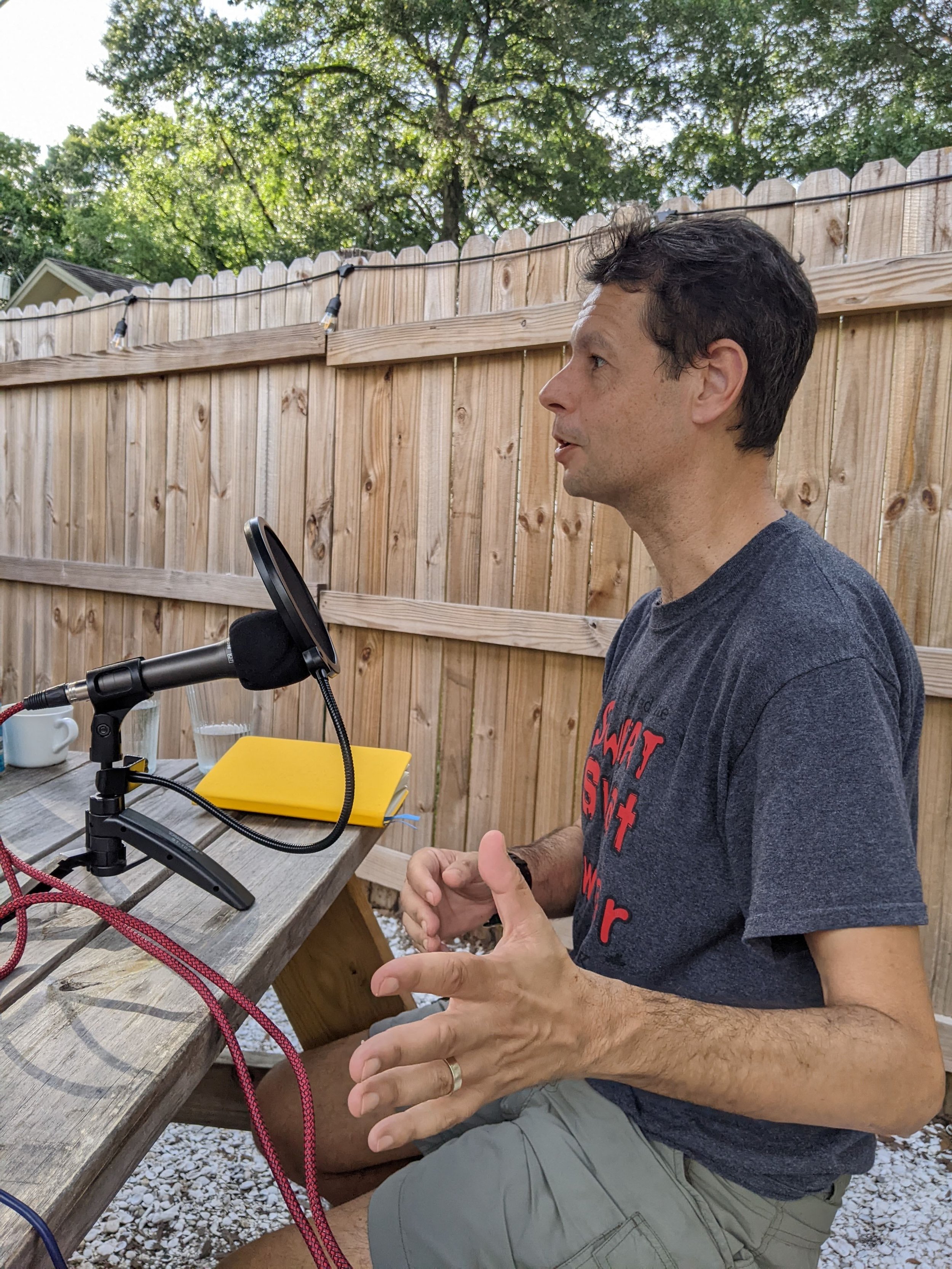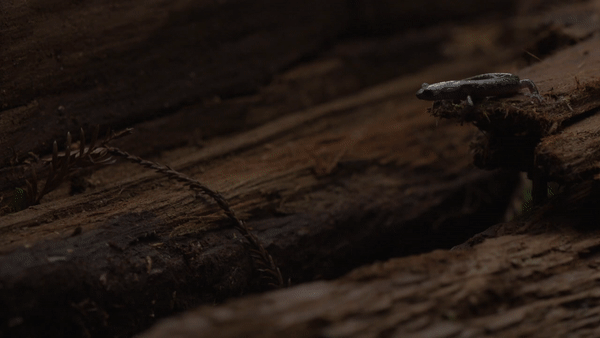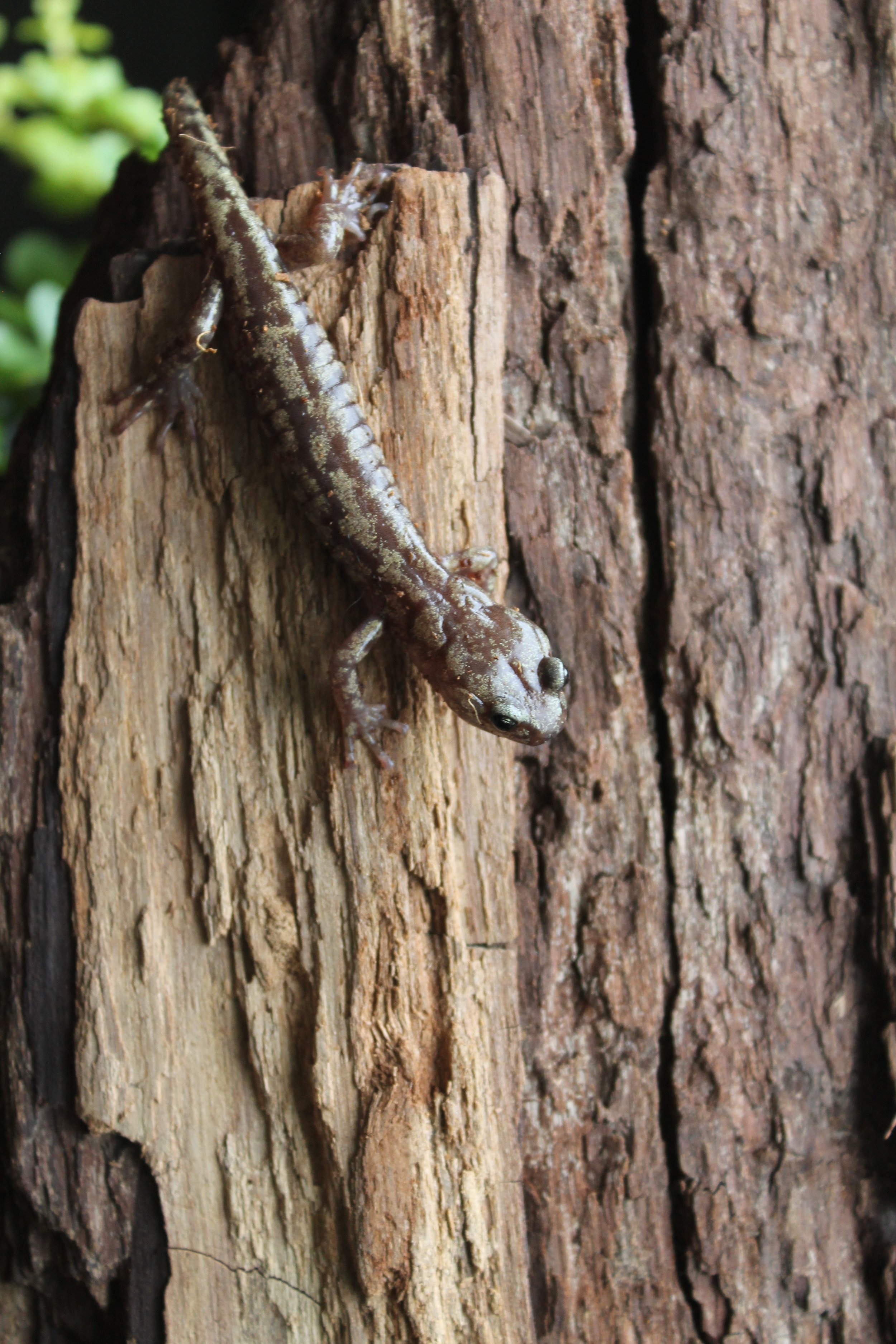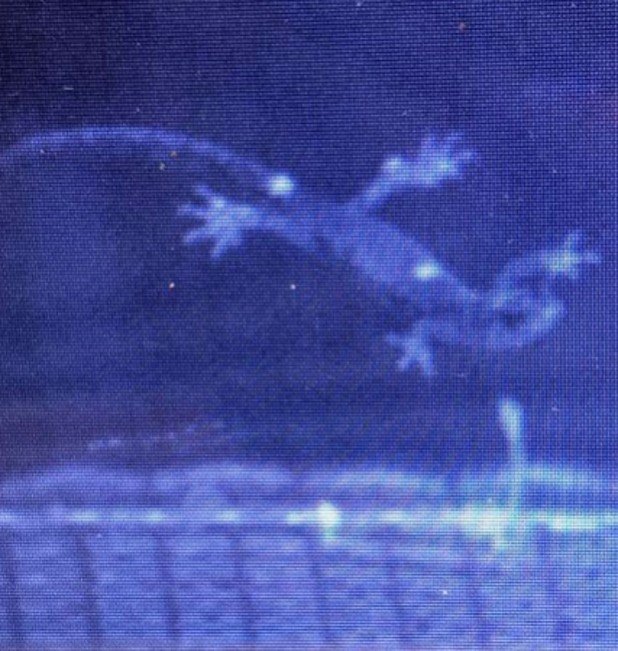The salamander scientist
He conserves wild spaces, he climbs tall trees, he records flying amphibians. He is: Christian Brown – the Salamander Scientist! We talked about his graduate research involving dropping salamanders in a wind tunnel, watching hours of recordings to get his data, and his work outside the lab to save a local forest preserve.
The track featured in this episode is “I think I’ll be their God” by Christian’s very talented brother-in-law Ryan Culwell. Find more of his music and videos on his website: ryanculwell.com.
Listen:
All the promised links we mentioned in the podcast:
You can find the original article here. (Sadly behind a paywall, but you can always ask for a copy!)
Christian’s website and his YouTube channel.
And the final link to learn more about the initiative Save the USF Forest Preserve.
Some salamander images: (1) a GIF of a salamander jumping from a ledge, (2) a salamander clinging to a vertical tree trunk head downwards, (3) a salamander floating in a wind tunnel captured using tracking software.
Watch:
Subscribe to our YouTube channel now for all future recordings.
Episode transcript
[Background intro music playing is "I think I’ll be their God" by Ryan Cullwell]
Parmvir: So friends welcome back to another episode of our 2Scientists podcast where inspiring scientists share their work with you wherever you like to listen.
Today's guest is a graduate student at USF, a biological researcher, a mentor, a teacher and activist. So that's a lot.
Welcome Christian Brown. How are you?
Christian: I'm great. Thanks for having me.
Parmvir: So we're going to get into probably pretty much all of those things, but um, the key thing that stands out about your you and your work is, how does one become a salamander researcher and why? And so essentially with that, I'm asking what inspired you to take up this kind of work and what was your route to get there?
Christian: Yeah, that's a good question, because I don't, I don't really know the answer myself. I just kind of pulled on a bunch of little threads and ended up here. But I was chasing scientific questions and, salamaders happen to be really good vessels for answering a lot of scientific questions.
It really helps that as a kid, I've always wondered where on earth amphibians go when you don't see them. So, uh, when you think about amphibians and you tell people, you study amphibians, they'll often tell you a story of a time they were out on a spring night and, you know, the salamanders were everywhere.
They were out breeding and on the surface, and that's a magical moment. But where do they go after that? I've always kind of wondered and, even the best scientists that I could find would just say, oh, you know, underground. But what are they doing underground? Are they, you know, are they just sitting there? Are they moving around in like a labyrinth of cavities and tunnels? And are they living their lives down there? Are we missing it? And so I've always been curious about like, kind of what they're doing when we can't see them. And I think I really got into salamander biology officially when I started tagging and tracking the salamanders, because at that point, you know, I, I had names for them. I had numbers for them. They were in my journal, and I could go back year after year and find them in the same place. And, at that point it really kind of took off. All I thought about was salamanders, and here we are today.
Parmvir: Yeah. So you say you have names for them. Were they like Fred and Bob?
Christian: No, not exactly. Usually 15 digit alpha numeric codes, uh, pit tag numbers.
Parmvir: So a bit less friendly,
Christian: Unless they have some kind of really distinguishing feature. So there's a legend of Rita the salamander, at the Mexican Cut Nature Preserve in Colorado. And she's a tiger salamander who got over a hundred grams.
And so we took pictures with her and, you know, she was a massive paedomorphic tiger salamander, found at the top of a mountain in Colorado. And so, uh, Rita, we definitely had a name for, and a few others like that distinguish themselves. But, there's too many to keep tabs on. There's thousands of them out there.
So, yeah.
Parmvir: So before we start talking about your research, can you tell us what the defining characteristics of, amphibians and specifically salamanders are?
Christian: Sure. Yeah. Definitely their skin. That's the first thing that people usually go to. So, uh, they kind of have to stay moist. They breathe through their skin, especially these lung list, salamander that I'll be talking about today.
They have no lungs, so they're not breathing oxygen. The way we do the oxygen, is absorbed through the skin and the skin must be moist. And so that's kind of the first thing people associate amphibians with is moisture and aquatic habitats. Another thing is, you know, they often have to return to water to breed.
They don't have these like hard eggshells that a reptile would have. Uh, they don't have hard scales that a reptile would have. And they're much more aquatic than reptiles and other things like that.
And reptiles have, many more adaptations for living on land. So a lot of the distinguishing features of salamanders are kind of tied back to that moisture and that aquatic habitat.
Parmvir: Yeah. So as someone who works on the lungs, it kind of freaks me out that they don't have any.
Christian: yeah. Kind of ironic that I'm here with a lung researcher.
Yeah.
Parmvir: Yeah.
Christian: But, uh, the, the funny part is, well, I guess it's funny to me, most salamanders, if you're going by number of species don't have lungs. So the largest and most diverse family of salamanders on earth is plethodontidae. And that is the family of lung-less salamanders, and you know, they don't have lungs. They, they go in all these crazy places and the ones I study don't return to the water, like we talked about, uh, they don't have to return to the water. They can survive just fine on the moisture of the redwood canopy. And there's a lot of salamanders like that. And because of that, they've been able to, pioneer a lot of different habitats.
So you can find salamanders now in caves, plethodontidae lung-less salamanders, in trees, Uh, so all of these, you know, it, it's kind of, it's almost like it's freed them from an evolutionary constraint where they're able to leave the water. They still need moisture, but they can leave the water and seek out these new niches, uh, and not come back to lakes and ponds and rivers and places that we associate salamanders with.
Parmvir: That is very, very cool. Another thing that's very cool is the fact that in order to study yours, you mentioned in the little bio that you shared with us, that you climb to the top of mountains and very, very tall trees. And so for me, I have a vague idea of what field research must look like because I have a few friends who go out and do stuff like that, but what does it look like practically for you? Because I'm trying to figure out, is it like a nature photographer? So you just kind of like, hang out there for ages, hoping to see one, or are they everywhere or...
Christian: That's a really good question. If you were to just climb up into a redwood tree, you would be sitting there for days waiting to see one, for a few reasons they're secretive creatures, uh, and they also know you that you're there.
They can feel the vibrations in the tree. They're not gonna just come out, uh, right in front of you. You're a potential predator and so, yeah, climbing the trees and just waiting for them wouldn't work. And this was actually something that, Jim Campbell-Spickler figured out. He's a scientist, a wildlife biologist, canopy ecologist, and he's also the director of the Eureka Sequoia park zoo in California. But he figured out that if you climb into these trees, and you leave these crack boards, which are basically cover objects that, uh, we rigged up to, to kind of meet the specifications of the habitat requirements of these salamanders. So they really like to live between freshly broken redwood, in about one centimeter wide cracks. So any wider than that predators can get in and predate them, uh, any narrower and they have trouble turning around and doing their thing. So what we do is we just buy redwood boards from the lumber company, which is, you know, kind of funny, we're buying redwood on the ground and taking it back up into redwoods.
Uh, but you gotta do what you gotta do. Uh, and they have these little spacers in them that are one centimeter thick. And the salamanders just crawl in on their own. And when we climb up into the trees to research them, they're hiding in there thinking they're safe and we just open the door and we're like, hello!
[Parmvir laughs], so it's, it's kind of crazy, but yeah, when we climb up there, we just have these little boxes and you just pluck 'em right out, takes a little while for them to season if you will, up there and for the salamanders to find them, so you gotta wait 6 to 12 months for that to happen. But, once that happens, and that happened, you know, we've established these boards decades ago, uh, in the redwood canopy, Jim Campbell-Spickler did all of this work. So yeah, I was able to come in and kind of build upon his science and that's what science is all about. Uh, he brought me in under his wing. He taught me how to climb the trees. He gave me the confidence to climb the trees. And then yeah, he showed me how to build the crack boards and, and make little habitats for salamanders to climb into.
So when we go up, we just capture them from cover objects. And, the cool thing though, is that we've been marking them with pit tags recently. And we just published a paper that shows that you can remotely detect them through the fern mats and through the bark of the trees. And so yes, we catch them at these manmade objects and, and whatnot. But now that they're tagged with these pit tags, we can actually scan the tree like a metal detector, and it goes, beep beep beep every time you wand over a salamander, so we're, we're learning a lot more about how they use the canopy habitat, uh, finding them away from the fern mats that we used to associate them with.
Parmvir: That sounds very cool. And it sounds much more easy to describe to people than my research.
Christian: Yeah. It's I mean, it's pretty rudimentary climb a tree catch a salamander. My five year old self would be jumping with, with joy. [Parmvir laughs]
Yeah.
Parmvir: So let's move on to the, what you're trying to achieve with these experiments. What is it you're trying to observe?
Christian: Yeah, so we we've studied a few different things, but ultimately broadly speaking, we're interested in this really cool behavior where these animals that live at the tops of the world's tallest trees, they jump really, really readily. Like if you have them in your hand and you barely touch their tail, or you just look like you're gonna touch their tail, they'll jump right out of your hand. And where they're living, you know, that would have major consequences. Uh, so we were really interested in the jumping behavior and what happens after the jump. And so we looked at the jumping first and, you know, found out that they jump a little bit differently than other salamanders. Um, but ultimately, like we said, the goal was to figure out what is going on with this behavior, with this, predator evasion tactic, what happens afterwards and how does that affect the salamander? You know, because if you fall all the way to the forest floor that could have major consequences for your survival, for your reproductive, fecundity, and therefore for your, you know, your genes and your evolutionary selection. And so, yeah, I guess if I could rephrase, we're broadly interested in jumping behavior in highly arboreal, salamanders, and the aerial, behaviors that come after that jump or fall.
So that's kind of what we're after is just describing what happens to a salamander in the air after it jumps from a tree.
Parmvir: And so that leads rather nicely onto, how we found you. So I was just scrolling through Twitter and a bunch of some of the, the bigger Twitter accounts that deal with like naturalist stuff and wildlife and so on. They were sharing this really cool video of a little salamander in a, what was essentially like a wind tunnel. And this thing just floating there and it got so much kind of press, I think. And it was only when it got shared by a USF account. I realized that you are one of my colleagues, which is why you were here today.
Christian: Small world.
Parmvir: Yeah. So we will definitely link to that paper and the little clip in the show notes, so everybody else can see what it looks like. But what was it like to discover that? And how did you discover that?
Christian: Oh, well, it was, it was a long journey. Uh, like I said, pulling on a lot of different threads that kind of led us here.
And it was really exciting to discover this. We did not expect this to happen when we dropped them into that wind tunnel that you described. Uh, we expected that, you know, maybe they could keep themselves upright and, and maybe that would be about the extent of it. Uh, but to kind of bring you into that moment, the first time that we dropped one into the wind tunnel, we dropped a wandering salamander from, you know, the redwoods into this wind tunnel. It immediately righted itself assumed that parachute posture, never flipped over and just kind of hovered in the middle of the wind tunnel, uh, to the extent where I, I don't have an exact quote, but my colleague, Dr. Robert Dudley at UC Berkeley, he exclaimed something like, holy cow, , you know, something like that. And I'm just a grad student. I'm not an expert in aerial biomechanics. Um, you know, I've always just chased salamanders. So when I saw Dr. Robert Dudley, one of my mentors and an expert in aerial behaviors say, holy cow, at the first salamander drop, I knew we had something.
And that excitement kind of lived on through that first day. We dropped another one and another one and another one. And the same thing happened every time. They were in total control. And you know, what doesn't come through in the scientific papers are the things we don't really have data on that we just observe when we're there in the lab.
And so one of those things is, uh, these salamanders knew what they were doing. They had done this before. Uh, but as soon as that wind tunnel was turned on and we hovered them over in the middle of it, if they came in contact with that airstream, they started assuming these postures and behaviors, even if they were still in my hand.
Parmvir: Oh, wow.
Christian: So there was something about that flowing air that triggered it in them. It's instinctive. Um, and so, yeah, it's ingrained in them. You know, they live at the tops of the world's tallest trees and the crowns of the world's tallest trees. So if you're gonna find aerial behavior in any salamander on earth, it should be that one, right. And so that's kind of why we started there and, they did not disappoint. And from there we kind of tested a gradient of arboreality, a couple different species of salamander within the same genus and one from a different genus, um, that are all different in terms of how much they use trees and how much they climb.
And we found that the aerial behaviors actually track with the arboreality. So the more arboreal you are, the better you can parachute. And the more often you parachute in glide, uh, and as you get less arboreal, um, not only can you not parachute in glide, but you start to exhibit behaviors that we never saw in the arboreal species, such as flailing around or what I like to call inner falling, where they're just kind of in a standard, like ground position that you'd imagine a salamander on the ground being in. Yeah. And it just kind of flips upside down and tumbles to the bottom of the wind tunnel and crashes and burns.
So yeah, it was, it was that stark contrast between the highly arboreal salamanders that seemed in total control and never flailed, and the ones that would go upside down and flail around and didn't seem to know what they were doing in the wind tunnel. That contrast really told us that there's something special about these arboreal salamanders.
We're still trying to figure out like exactly what that is.
Parmvir: So when you say arboreal, bleh, bleh, bleh, you can say it because I can't apparently. Can you repeat the word and, define what it means?
Christian: Yeah, absolutely. Sure. So, arboreality in salamanders is pretty common in terms of, just tree use. And so arboreality, we refer to, you know, using trees. If an animal lives in trees or spends part of its life in trees, then it can be described as arboreal. And hundreds of species of these lungless salamanders have been found to climb, and many of them have been found to live in trees. But these specific salamanders live in the world's tallest trees and therefore would have the longest, time in the air, and therefore we thought, would be the most likely to have some aerial behaviors or some kind of control over their descent. Yeah.
Parmvir: So you talked about how this is very instinctive. So, my friend and colleague Sue asked us on Twitter, do you know if this is innate or learned?
Christian: No.
No, absolutely not. That's what I, that's what I mean when I say we have no data on this, we were not testing this. This was not the goal of our research, but just, you know, between you and I, two human beings, when I held this salamander into this wind tunnel, it was not even out of my hand yet. And it was already assuming a parachute posture. So there's something about the airstream, I'm not sure if it's learned, I'm not sure if it's innate. But you know, it's interesting. So in 2005 Wassersug et al., they did a study where they put amphibians and reptiles into parabolic flight, which achieved zero gravity for, you know, a few seconds and they found that a lot of amphibians and reptiles with four legs assume a parachute posture in zero gravity.
So yeah, I'm not sure if it's learned or innate, but that's another kind of interesting observation, of salamanders that went to space or sorry of amphibians that went to space. I'm not sure if there were any salamanders specifically, but,
Parmvir: Okay. So when we're talking about parachuting, it's actually more like humans who put on these, what are they called? The weird suits where they can...
Christian: Oh, wing suits.
Parmvir: Yes. Because at least for me, the impression I got from looking at that little gif was they, they spread out a bit like a human would in one of those suits.
Christian: Yeah. So bringing up the wing suit, that's actually an interesting observation because there is this really cool trade off in aerial biomechanics between maneuverability and stability.
So having a wingsuit and having like skin flaps, like a flying squirrel, if you wanna imagine a sugar glider or a flying squirrel or a human in a wingsuit, this makes your morphology or your body shape very stable in the air. But there's a trade off between stability and maneuverability. So, these salamanders aren't really stable like that.
They don't really have skin flaps like that. They're not kind of operating in the same way that like a Draco lizard would or any of these other organisms that are famous for their skin flaps, uh, and parachuting and gliding. It's more about like constant maneuvering. So instead of being stable, their morphology is a bit more maneuverable where they have these big feet, on these long legs, they get far out away from the center of mass, and that gives them control over the center of mass.
So the longer, you know, the further from center of mass, you get the more control of that center of mass you have in the air. Um, and so it's more like they have these big paddles. And they use them. They're constantly fine tuning them and adjusting them, even in the video that you reference, it looks clean. That's the reason we use that one for the, for all the footage for the press releases. But if you zoom in and you look very closely that salamander is constantly adjusting its feet and its toes. So they're just kind of doing like a, a maneuvering trick where they're just, you know, constantly maneuvering in the roll, pitch and yaw planes so that they never go upside down.
And if they start to pitch or roll in one direction, they actually use subtle movements of the limbs tail to roll or pitch back in the other direction. Um, so they're constantly pivoting, in all planes, but it's this kind of balance that they can do. It's a balancing act in the air where they're, constantly maneuvering their legs. And when they have those big feet out on their long legs like that, it does, you know, in theory, this is what we're still testing this, but create drag, slow them down, um, and account for, for some of the parachuting.
Parmvir: Yeah. Today is one of those episodes where I wish this was a video podcast, because you should be able, you should see Christian with his arms out and waving his hands around.
Like it's an excellent demonstration of what we wish the rest of you could see.
So you've talked a lot about what you've done and how you do it, but what are the implications of your research?
Christian: Yeah. So there's a few implications of, you know, of, of this research, the fact that salamanders can parachute and glide, or have any aerial behaviors at all was sort of new to science, you know, people have probably seen it before had observations, but we had never seen it described. And so just having some sort of aerial behavior, or description of aerial on salamander on the books was the sort of the first like, big finding here.
But really deep down, like the implications are bigger than that. These salamanders are unique. They do climb trees. They do have very big feet and very long legs compared to other salamanders like them. However, they still have that super basal four-legged vertebrate body plan, right? It's a tail, it's a body, it's four legs and a head. And so this has implications for, all types of other organisms that we've overlooked. There's not that many scientists climbing up into a lot of trees. You know, scientists live on the ground, most of the time. There's a lot of great canopies biologists out there. But relative to the number of scientists and studies that we have on the ground, it's, you know, it's a fraction. Um, and so what remains to be seen is how many other unassuming species have cool aerial behaviors or have the ability to flip themselves over or parachute or glide that we just haven't looked at, because they don't have skin flaps or anything visually, you know, cueing us into the fact that they might have those abilities. So there's sort of implications for other organisms, all types of organisms with four legs and whatnot.
And you know, one of the coolest things I thought about this was it, it's almost a new form of locomotion for salamander, because we've talked about this so far in the context of, you know, they jump outta the trees to get away from a predator. And then they have to deal with the fall. But we're not exactly sure how they use this in the wild.
This is our best hypothesis because they have done it in our hand. Like, so researchers, while climbing the tree have captured wandering salamanders. And while the wandering salamander was in their hand, they jumped out of their hand and fell all the way to the forest floor. It was, you know, as somebody's studying like the movement and the population, it was a horrifying event, but, it does show one thing that they're not afraid to take a leap of faith if they think they're in danger. And so that is one reason for that hypothesis.
However, there's a lot more going on in that canopy. There's a lot more than just predators. So you're an amphibian. You have to stay wet. You can't breathe if your skin isn't moist. But we live in a Mediterranean climate in California. So there's a few months outta the year, many more months now with climate change where it's very dry and there's no rain. And so these salamanders. You know, that's one of their biggest, uh, hurdles is, is not desiccating, not drying out. We have found dried out mummified individuals in the canopy. It is a harsh world up there. They have fern mats as refuge, so lots of arboreal humus, and ferns and soil that they can hide in and kind of prevent themselves from drying out.
But their name is the wandering salamander. And there's a good reason for that. They're known to just wander the redwoods and you might wander up a redwood tree looking for more habitat. Maybe you're looking for a new fern mat or a new mate or more bugs. And if you wander up to the top of the world's tallest tree and you don't find what you're looking for, why would you waste all the energy and the time and the risk of drying out, walking back down?
Parmvir: Yeah.
Christian: So I really think what we found here, and there's no way to back this up yet, we have to do a lot of in situ field studies, but I really think what we may have found here is a new form of locomotion in salamanders. Dropping, parachuting, gliding from one fern mat to the other.
They live in a very vertical habitat. So, you know, to get away from a predator or to find a new mate, or to just prevent drying out in the upper canopy, it's much faster and much more efficient to return to the lower canopy on the gravity elevator than it would be to try to walk back down. And just to highlight a little bit more USF research, Jessalyn Aretz, she was an undergraduate researcher here at USF Tampa. And she's now a master's student at USF St. Pete, with Dr. Alison Gainsbury. So she did a study on how these wandering salamanders from the redwoods climb straight up and straight down walls. And what she found, you know, I came in one time and I said, how's your research going? And she said, ah, not so great.
I said, what's going on? And she was like, I can't get them to walk down. And I was like, what? You can't get them to walk down, show me. And she put it on the board and she'd tickled the tail and do all the things we do to annoy salamanders and get them to do what we want them to do. And it wouldn't go down, you know, like they really wanted to go sideways or up, or, you know, anything other than down.
And she was able to force a few to walk down and we were able to get the biomechanics on that. And she published a paper in zoology that was really cool, but, that is actually a super cool observation that they don't wanna walk down. You know what I mean? Like that, I think to me, that's a huge implication that in the wild they're actually doing this more often than we might think it might not just be that one time an owl is coming to get you. It might actually just be seasonal when that Mediterranean climate rolls in. And you've been partying in the upper canopy while it's, while it's rainy season [Parmvir laughs]. Well guess what? The spring tails are drying up, you know what I mean? And you've gotta return to that lower crown where there's more moisture, there's bigger fern mats. There's lots of data on that. We have great botanists up in the redwoods that have published lots of cool data on the habitat and the plants up there. And so I think they're dropping from the upper crown to the lower crown, and it's sort of like a new form of locomotion in salamander. So to me, that's the coolest implication, but maybe not the broadest. Yeah. Yeah.
Parmvir: That's
Christian: Sorry. I talk a lot about salamanders.
Parmvir: No, no, no! You're good.
I'm also thinking of me as a human and how I do the exact opposite.
Like if I'm gonna do anything, it's gonna be the elevator up and walking down the stairs. Right?
Christian: Well, and if there was an elevator up, perhaps they would.
Yeah. But there's,
Parmvir: This is true.
Christian: Yeah, exactly. And, so one last implication of this research, and this kind of, for me and for the herpetologists out there that are like really herpetology nerds. Uh, if you're a big herpetology nerd and you knew about these salamanders, you probably knew about the big feet and the long legs that I've been talking about. And you probably read in a lot of those field guides that that was for climbing. That that was an adaptation for climbing. But here's the question I would like to ask all my fellow hepatology nerds out there, if that is an adaptation for climbing, then why don't the other hundreds of species of salamanders that climb have long legs and big feet.
Parmvir: Yeah.
Christian: And I think that perhaps it's because there's something else going on that these ones also fall and jump outta the world's tallest trees. And so in theory, that selection pressure to me, like if I think about, you know, selective pressures of big events falling outta the world's tallest tree is gonna have a bigger impact on selection than if I climb a little faster or slower.
And so the implication of this research in the herpetology world, if you are such a herpetology nerd that you know about the feet of salamanders, then you might be excited about this research because it kind of means or could mean that their big feet and long legs were actually an adaptation for falling and gliding and parachuting, and not for climbing, but they happen to help with both.
Parmvir: Yeah.
I guess it's much more dramatic to think about. So we, obviously we live in Florida and the trees here are by and large, they're very small and the redwoods are absolutely enormous. Right. It's still on my wishlist to go and see them. But yeah, it conjours up a very vivid image of how far they must be coming down and exactly how sure they must be, that they're going to survive that fall.
Christian: That's right yeah. They're mind bending trees. The height is amazing. Uh, so the tallest one on earth is about 381 feet. So imagine a 38 story building, but it's a tree. So these trees are absolutely massive. And, if you're a listener in Florida and you are here at USF, I think the best thing to do to try to imagine this is to go into a Cypress forest. So the bald Cypress is actually in the same family as the coast redwood, and so they grow very similarly and they both have, you know, fungal resistant properties and, you know, they're kind of similar to redwoods. So go look up, you know, look up the trunk of the tallest Cypress you can find and then double or triple that, uh, and imagine a salamander jumping and falling that distance. There's a lot of time there there's a lot of time to maneuver. There's a lot of time to flip yourself over. There's also a lot of time to, you know, start moving a little bit horizontally.
So we found that when they fall, they can achieve about one meter sideways for every 10 meters down, which might not sound like much. But if you stand back and look at a coast redwood tree, their native tree, it's perfect for the shape of that habitat. Uh, so if you drop 10 meters in a redwood, but you move a full meter over while you're doing it, you're much more likely to hit another branch or another fern mat on your way down than if you were to drop straight down.
So that subtle glide angle, just a few degrees, five, six degrees doesn't seem like much, but it's just enough and it can make all the difference to, prevent them from falling all the way to the forest floor. Which the number one question I get there is well, is that because it would kill them that fall would kill them. And the answer is that we don't know, we haven't tested it for ethical and logistic reasons.
Parmvir: Yep.
Christian: But in theory, no, it would not kill them. The redwoods have a nice soft kind of redwood duff forest floor, and the salamander only gets to five or six grams and so it shouldn't necessarily kill them unless they land in like a fast flowing river or on a sharp rock or something like that.
But these sub lethal effects would be astronomical. You're now separated by, you know, a hundred meters from all your mates. You know, you're, you're separated from your niche and your food, and there's other predatory salamanders that live on the forest floor. There's the Pacific giant salamander that can get up to 18 inches in length. And it absolutely would eat a wandering salamander if it got the chance. So staying up in the tree is a way to keep you safe from other salamanders; competition and predation. Um, and it's a way to like live amongst your mates So you can easily find a mate when the time comes and you don't have to go very far. because you could dry out if you do.
Parmvir: Very nice. So they essentially have their own little tribe up there.
Christian: Yeah. It's all them in terms of the salamanders it's a free for all for Aneides vagrans for the wandering salamander. There's no competition for them in terms of salamanders up there whatsoever.
And there is a boom bust cycle with the spring tails, and we know that spring tails are very important food, for, terrestrial, hatching, salamanders.
One other interesting thing about the species I should mention is when they come outta their eggs, they're just like mini adults. They're called direct developers. Yeah. So they, they don't actually have a tadpole or a larval stage. They're just called hatchlings for a while and then they get big. And so yeah, when they hatch they're literally hatched on a vertical surface. So the females will lay eggs. I've got a video on YouTube if you wanna check it out. It took her over a day to do it, but so it's a time lapse. Yeah, so Google Aneides vagrans, ova position or egg laying or something like that, or wandering salamander or laying eggs, and you'll find it on YouTube. But I said all that to say that they lay them on vertical surfaces, these eggs, and when the hatchlings hatch, they're literally born onto a vertical wall onto a vertical world.
And so that's what I mean when I say that this seems instinctive, this seems innate in them. Being vertical is innate to them being on vertical surfaces and high up off the ground is just something that comes with being a wandering salamander.
David: One of the things I was going to ask, which is that every, every scientific activity really is either about data collecting or about theory making. And I belong to the theory making side. I mean, as a scientist, you can be involved in both parts.
Christian: Mm-hmm
David: But most of us specialize in one side or the other.
So Parmvir, for instance, is an experimentalist, her job is to do experiments and collect data. And there's a bit of theory making in the sense that obviously you have to make sense of data, but you didn't spend much time thinking of big equations. Whereas in my case, actually, I don't spend much time thinking of big questions because I'm not smart enough, but I do come with computational models.
Christian: Yeah.
David: My work is, get data and then trying to figure out how does that fit? Like what does it mean? Try to sort of make something out of that. You do collect data. It seems to me like a lot of the fun part that you're describing is going to California climbing up trees. Try not to die.
Look at these beautiful creatures who won't die if you push them because they know how to fly, which is amazing. But then you go home. I mean, you are at USF, you do research at California. I expect that most of your time, you're not really in California. That would not be.
Christian: Correct.
David: Yes. So what do you do when you're here?
Christian: Yeah, I love that you brought that up because, you know, the video that we talked about, so much of that salamander just crisply floating through the air in the wind tunnel, that video was collected four years ago.
We just published this, and when I first, you know, quote unquote discovered this you know, I would tell people about it and, scientists would be like, okay, well, you know, what's the data, like how much is it slowing itself down? And I would be like, no, no, no, just look. I would just like, hold the camera up.
You know what I mean? Like, no, you just look at it, see it's doing it. But yeah, we actually did have to crunch the numbers and it's not trivial. We had a lot of those videos. So what I do with most of my time here at USF is when I'm done in California with it done with the animals done with the wind tunnel that I use at UC Berkeley.
I come back here with my videos, and you know, a few animals too, to collect some extra data if, we realize we missed something, and I go through those videos, painstakingly. I mean, days and days and days worth of video crunching, like I did the numbers one time and it was like, oh, I have like 256 hours of video analysis to do this month. Or like something crazy like that.
David: Yeah.
Christian: Um, where I knew I had to dedicate like entire weeks to this. And so basically what it involves is running these videos in through software, and then you follow points on the salamander and you create like digital pixel points and then you can convert those to real world points, and get like actual distances because you know, the scale, And so you can then 3D reconstruct these salamanders' movements within the wind tunnel. And once you've 3D reconstructed them, you know, you can write all types of code, and you can, every single video, I can basically plug into some code, you know, hit some buttons, type some things. And the next thing, you know, we have like accelerations velocities in all directions, X, Y, and Z. You know, we've got glide angle, we've got, horizontal velocity and horizontal acceleration, which would kind of imply like how far did they move sideways and that in this amount of time, and how far would they have fallen down in that amount of time?
So we get all these cool, like mathematical variables, kinematics, if you will.
David: Yes.
Christian: On like speeds and angles, then that allows us to actually say, yeah I have this video, sure I can shove this YouTube video in your face and say, look at it. Yeah. [Parmvir laughing in the background] It's gliding, but now we also have the numbers to say yeah, but it was also going 10 meters per second when I first dropped it in and now it's going 8.9. So like that's kind of cool.
David: Yeah.
Christian: Slowing itself down more than 10%. Um, and so yeah, the numbers really helped us contextualize, like what's going on because it all happens in the blink of an eye. We have to film this at 500 frames per second, and because of that, all of my videos are like six gigabytes.
I have so many hard drives. It's ridiculous.
David: Yeah.
Christian: So part of my work at USF is basically just like living with my hard drives in the lab and in my bed at home all night long, like point tracking is what we call it. And you point track the salamander's movements and you get the kinematic data.
Yeah.
David: Because obviously a paper is not going to be: here is 200 gigabytes of videos. It's going to be here is some videos we took, but obviously this is what it means.
Christian: Correct.
David: Why are we interested in kinetics. Do you guys do any biophysics as well? Because it feels to me that probably the morphology that the shape of these animals might actually play a big role, right?
Christian: That's an awesome question. So that's actually what I'm doing right now. Once we figured out that they could do this, then the next question was how, right? How are they doing this? And I talked a lot with Parmvir about the, you know, the big feet and the long legs and that's my hypothesis that I'm currently testing because I read in a fluid dynamics textbook, by Vogel that, like I said, the further you get from the center of mass, the more control you have over that. So you can turn better and, you know, flip over quicker and do all these cool things. If you have longer legs and get further from your center of mass.
So to test that, I've linked up with the Ryan Carney lab. He's in IB, but maybe also USF health? Um, he does dinosaur reconstruction stuff
David: Oooh
Christian: and also does mosquito-borne diseases and Jack of all trades, his graduate student, Alex Kirk is the TA for digital dinosaurs. He's like an award-winning TA for that class. And I was talking with him about that class one time and I. Hey, man, I should take this class and then my class project should be the salamander. And he said, don't take the class, just come to my lab. So I'm now collaborating with Alex and he's really helping me a lot where we, uh, laser scanned the salamanders, which are euthanized right.
In, in these parachute postures. So I euthanized them because that's the protocol. Once you collect an animal from the wild, you cannot put it back because you could spread diseases and kill thousands in the wild. Instead of just the five I collected for the whole four years, I did this project. So it's a lot better to just collect them and euthanize them in the lab, even though it's a bit harsh.
So I euthanized them and then I fixed them with formalin in these parachute postures.
David: Mm-hmm
Christian: And then we scanned them with lasers and then we brought them into Maya some software like that and we made a mesh. And so now what we're doing is we're using computational fluid, dynamic software, ANSYS fluent, and imagine a car commercial, and they're trying to show you how aerodynamic the car is and they have all these like colors flying over the car and those show showing you where it's got drag and where it's really smooth and sleek. We're doing that with the salamander. And we're basically seeing like, where are the positive and negative pressure areas, and therefore, I guess in non fancy terms, where's the lift being generated here. And, you know, just a sneak peek, we haven't finished collecting the data, but our preliminary results are suggesting, I think more than anything, it could be their flattened body. They have a really flattened torso, which has always been attributed to climbing and, squeezing into cracks but that flatness really influences aerodynamics. There's a whole chapter in that, fluid dynamic textbook, uh, there's a whole chapter about things going around, things that are around versus flat. And so a lot of salamanders are round and these salamanders are flat.
So I think that's a huge thing in terms of their aerodynamics. And we sort of have the data right now to prove it. And we're working on that now. Like I said, Alex Kirk, USF biology, it's kind of a collaboration between the Carney lab and the Deban lab. Really excited about that work coming out.
David: So salamanders in general, not just the ones you study, but in general they do live in lots of different habitats.
Christian: Yes.
David: Can you say that the taller, that the higher they live, the flatter they are?
Christian: Hmm, that's a really good question. So yeah, the taller that they live in, the trees, would they be flatter? And, uh, the answer is, I don't know, but, that is something that could easily be answered with like museum work. So, uh, you know, specimens in jars that were collected throughout the last couple of centuries that are just sitting there on shelves in museums, I could easily pull them out and measure morphometrics and, and even run genetic tests and kind of see, like, if there's any kind of like correlation, like you said, between arboreality and, and body flatness, that'd be a really good idea.
But we talk so much about these salamanders, this north American salamander. It's really important to emphasize that some of the coolest arboreal salamanders in the world are down in Mexico. There are these Bolitoglossans, uh, they're also lungless. But they live in bromeliads and banana trees and stuff.
David: Mm-hmm
Christian: Sure they fall off of those too.
Uh, and a lot of these have like webbed feet or semi webbed feet. So one thing I'm really interested in doing possibly for a postdoc is, trying to identify like the genes behind webbing in salamander feet, and then seeing if that correlates with arboreality and aerial behavior. So it's something I think about a lot.
David: So changing tack a little bit, where were you before you started your PhD here?
Christian: So before my PhD here, I was in a master's program at Humboldt state. And that's where I fell in love....
David: Which is in?
Christian: Oh, it's in California. Sorry. Yeah. Humboldt State University.
David: So are you from California originally?
Christian: No, I grew up in a, like an air force family, so we moved all over the place. But I did my masters' there spent three years there and that's where I kind of fell in love with the canopy world and, and with the salamanders.
And the reason I came here to USF was, Dr. Steve Deban's work. So if you look on YouTube, I'm always talking about YouTube here. We're flooding YouTube with salamander videos, try and stop us.
David: Bring more of those. I think youTube needs more salamander videos.
Christian: I agree. Absolutely. Uh, I'm helping with that.
So, Dr. Steve Deban, uh, he actually did a lot of work on, uh, ballistic tongues in salamanders, and I looked at those videos and I was like, huh, that's a small salamander doing a very fast thing. And I don't know if I mentioned earlier, but part of the reason that it was so hard to study this. If you drop them and blink, you missed it. They fall very quickly.
David: Oh,
Christian: So that wind tunnel video, it's like, it's in slow motion. There's wind below it, slowing it down. So the only reason you saw it for that long was the scientific equipment and the slow motion camera. But I had to come here to USF to learn how to use all those things. I had never used a slow motion camera before. So Dr. Steve Deban is an expert in biomechanics and morphology, and he studied salamanders too. And he had lots of fancy cameras and I reached out to him and, uh, he made me an offer and yeah, I was like, I never thought I'd live in Florida, but yes, here we go. Yeah.
David: Because I was just thinking, why would someone at USF decide to study something that is only reachable in California?
Christian: It's a great question, and unfortunately, this is something in academia that happens too often. When people ask about that, I often like to tell them the story of a lab in Oregon, that studies brown anoles. [David and Parmvir laugh] And they're all over our backyard and we're down here studying the salamanders that live in Oregon. So yeah, maybe some scientists should link up and trade salamanders and lizards, you know, things like that [David laughs]. But yeah, it's all about like, your mentor and your department and where somebody got a job. So
David: Yes.
Christian: Yeah, you'd think like, oh, somebody do you studies canopy salamanders must live with the canopy salamanders, but unfortunately right now I do not. Working on getting back there, if I can. Yeah.
David: Cool.
Parmvir: So clearly you're very, very excited about your research.
Christian: Yes.
Parmvir: Which is awesome. All scientists should be.
Christian: Absolutely.
Parmvir: It would be sad if you're not.
Christian: It's like it's thrilling. Yeah. It's truly thrilling.
Parmvir: I know that another thing that's really important to you is conservation and it just so happened by another complete fluke I've been following the save USF Forest Preserve hashtag and, I've been on their Instagram account.
If you go and check out our pictures for this episode, you will see that Christian's wearing, a t-shirt dedicated to that. So can you tell us about the work that you started doing there? How did it start up and what's the importance of what you do?
Christian: We've been talking so much about how I became a salamander biologist, I should mention that my undergrad degree was in conservation biology. I never intended to end up here and that's the way life should be. But yeah, I have a degree in conservation biology and so I've always been interested and passionate about this, and when this issue came up, when the request for information was first published for developers, and the USF Forest Preserve came under threat last year or two years ago, I got together with Jeannie Mounger and Stephen Hesterberg, which are fellow grad students, or now alumni in the IB [Integrative Biology] department. And we sat down in the middle of the preserve and we just said like, what are we gonna do? How are we gonna save this place?
Parmvir: So can you explain where it is first of all?
Christian: So the USF Forest Preserve, or as they call it, the North Fletcher property, is a parcel of land. That's about 700 acres, a little bit more. It's right across Fletcher from Carlton Arms apartments in Temple Terrace. It's just west of Lettuce Lake Park and USF Riverfront Park.
And so the USF Forest Preserve is a super important natural laboratory and also a super important resource for the Tampa community. So it's not just USF, it's not just USF students. It's everybody who lives in Tampa that benefits from this Forest Preserve. The students get a natural laboratory that has all sorts of native Florida ecosystems.
We have Sandhill with endangered gopher tortoises and wild flowers. We have Oak hammocks and, and Palm hammocks and, and we've got lots of Cypress, swamp. And tons of unique animals in plants to show the students. Um, and a lot of students that live or have graduated and live around Tampa, Zoo Tampa, the Florida Aquarium, they have told me that they get jobs after talking about their experiences in the USF Forest Preserve. It's hands on stuff. It inspires them. It gives them confidence and it gets them jobs.
So, you know, it's really good for the students, but it's also good for the community. It cleans the water, it cleans the air. For instance, the other day, you probably didn't hear about it because it's no big deal because the Forest Preserve was there to help us out about this, but they had a spill about 20,000 tons of sewage spilled at the end of 56th street, right there at the Forest Preserve. And you know, if the Forest Preserve wasn't there, the next thing is the Hillsborough River, which is our source of drinking water in Tampa. Uh, so you didn't hear about that story because it's no big deal because we have a wetland and a USF Forest Preserve there to absorb that sewage and filter it out for us and take care of it.
So it's a vital resource. If you like wildlife, if you go to Lettuce Lake Park and you like to look at the birds and the alligators, guess what? They don't just live at Lettuce Lake Park they don't stay there. You know, when the sun goes down, they don't all just go to bed at, Lettuce Lake and wait for you to come back.
A lot of them cross the Hillsborough River and they nest and they breed and they live in the USF Forest Preserve. Um, I run the game cameras back there. We have bobcats, we have otters. Um, you name it, we've got everything back there and it's a really special resource because it's actually a wildlife corridor that connects all the way back to the Green Swamp, which is a core conservation area of Florida.
So if you're not familiar with the core conservation plan, we have all these core conservation areas through Florida, and we're supposed to keep them connected with corridors. And this is a way for humans and wildlife to coexist. So wildlife can move between, the major parcels of land and habitat and resources in these, wildlife corridors.
And the Hillsborough river provides sort of a natural wildlife corridor from the Green Swamp all the way down through Temple Terrace, you know, to the USF Forest Preserve and the USF Forest Preserve is responsible for then linking that wildlife corridor to the Cypress Creek preserve, which goes all the way up into Pasco county.
So if we destroy this preserve, if we build on this preserve, if we do anything other than leave it alone or manage it for wildlife, we will lose and sever a connection between Cypress Creek from Pasco county, the Hillsborough River and the Green Swamp. Um, and that's gonna have serious implications for the wildlife that you see and serious implications for, a lot of other things, traffic and other things like that.
It's a natural barrier sort of between the interstate and New Tampa, and Fletcher Ave. So, you know, we talked to, Dr. Robin Ersing at USF, um, and she said that it, it could be a nightmare if they build there and put more roads through there, uh, that it's kind of like a natural barrier that keeps the USF community, um, the USF community is buffered from a lot of this traffic and a lot of this new construction, through the USF Forest Preserve. So it's a parcel of land it's here in your community. And it's doing stuff for you, whether you know it or not. And I like to tell people that, what happens at the preserve affects things as far away as the Andes mountains, because, we have nesting swallow, tailed, kites, that fly into the preserve and they go as far back, you know, in, in off season in the winter, they'll fly as far back, as the Andy mountain, Andy, Andes mountains, blah.
[Both laugh] Yeah.
Parmvir: So is it the lack of corridors, the reason why alligators end up in people's swimming pools?
Christian: Yeah, yeah, so human wildlife interactions, undesirable ones like that, are absolutely a product of destroying wildlife corridors, not giving animals and wildlife the space that they need to move between habitats, and developing in places that are encroaching.
And so, yeah, wildlife interactions is just one of many negative consequences of development and, you know, shortsighted, leasing out the land for development for short term economic gain. Right? When we have, you know, there's so much more value in that land than economic, there's teaching value, there's cultural value.
I haven't even mentioned the cultural heritage sites there. You know, there's evidence of human inhabitation there for the last 10,000 years. It's an incredible archeological and scientific resource. And natural laboratory, uh, and USF seems to be doing the right thing and they're, they're moving towards, you know, formalizing it as a natural laboratory, hiring somebody to manage the land. And, you know, we're very, uh, eager to be a part of that movement and, also keep their feet to the fire. Yeah.
Parmvir: So, I mean, I know you're talking about economic gain, but I think there are economic impacts by stripping people of this, because obviously the effects that you're talking about will affect people's health. We know the issues that come from stripping away, swamps and mangroves and things with the regards to how then our properties flood when the hurricanes and the storms come in. So, you know, you do have the negative economic impacts of those things, right?
Christian: Absolutely. Absolutely.
It's a lot more expensive to try to clean it up than it would be to, to keep it in tact. Yeah. So like the example with the sewage spill a lot more, you know, expensive and, and a lot bigger deal to have to clean up things out of our river than it would be to just keep them out in the first place. So there's definitely economic implications.
You know, everybody's in it for their own reason, I'm in it for the animals in the wildlife, but it affects people too. And, um, whether you know, it or not, like I said, the USF Forest Preserve is working for you.
Parmvir: Yeah.
So what is the status with regards to whether it's going to be developed or not right now?
Christian: [sighs] So the
Parmvir: That's a big sigh.
Christian: Yeah, uh, it's a never ending battle. We know that the Forest Preserve has been under threat many times in the past, and we know that it will be many times again in the future and that's the crux of it. That's the issue. That's why we really need permanent, like legal conservation easements or protections or something that's, you know, something that will enshrine that place in law. Something that will keep that place there for the community for years and generations to come, because without that, you know, land is only getting scarcer. Developers are only getting hungrier and what's gonna happen in 2050? What about 2100? Are we gonna have the same people in charge? Are we gonna have the same people running USF? Are they going to make the same decisions? The answer is probably no. So if we don't protect this preserve, properly legally, then we have issues. And so that's why I sighed. That was the deep sigh, was that the fight is never over and that we don't really have anyone other than the county of Hillsborough on our side, when it comes to permanent legal protections like conservation easements.
The University of South Florida has done a great job in nixing the RFI. So they did say we don't want any more requests for information from developers. That was a great step. We applaud that. They did say no, we're not gonna move on any of the proposals that we did get. That was a huge step. We loved that. They formed a committee and they did put somebody from our activist group on the committee, and they had that committee assess the property. That was very cool of them. I don't wanna get into the nitty gritty of that assessment or if it was good enough, uh, we have our, our qualms about it, but, you know, they're trying, they're making an effort.
But the, current threat and the current status of this fight, we don't know if it's a threat or not. That's, that's exactly why I sighed. So the University of South Florida, and, you know, the College of Arts and Sciences, they're now tasked with managing this land formally, they've never been tasked with that super formally before. It's just kind of been like, Hey, biologist, you wanna take care of this land?
[Parmvir laughs]
And we were like, yes. But that kind of fell through the cracks with a few retirements. Um, and so now with this whole push to nix, the RFI, they formally, made it ECORP and they're appointing a land manager, which again, we applaud, we love all of these efforts. They do wanna build a 5,000 square foot research building. We do not know where we can't really get a solid answer on where, and we don't know if they got the funding or not. And so that's kind of where we're at in terms of the USF Forest Preserve right now is the most likely development that will occur is actually by the USF College of Arts and Sciences, which are the very people that we're saying we cannot give another inch last year when this was, you know, an RFI for developers, they said that we shouldn't build there. Now they're telling us that we should build there, put this research facility there and that this building will then protect the land forever because it will mean that, oh, there's important science going on. I was told that the building would give the land legitimacy, which I disagree with on a moral ground.
And so yeah, I wanted to start with all the things that they've done well, and you know, we're working with USF. We love USF. We love, you know, the College of Arts and Sciences. We want to all work together and get to the same place, which is students learning on this land forever, but they refuse to talk about conservation easements. They refuse to talk about any option that, relinquishes their control in any way of that land.
And so what we're seeing, I guess, is just a struggle between some of us who just want the land protected, no matter what. And some of us who have to look out for the bottom line of USF. And so, yeah, of course we're working together, uh, but the current threat is a 5,000 square foot research building that may or may not have been approved or gotten funding.
We're still waiting to hear, and we can't get a clean answer on whether or not it would be in the Sandhill habitat, which is exactly what we just fought to protect.
Parmvir: Ugh.
Christian: And even if it's not in the sand hill habitat, if it goes anywhere, other than already developed land, like USF Riverfront park or The Claw, like the golf course, then it's gonna have an impact and 5,000 square feet isn't just 5,000 square feet. You need a parking lot. You need a road.
Parmvir: Yeah.
Christian: You need, you know, lights and facilities and construction trucks, and so all I want is to have a conversation about core conservation areas, edge spaces, and the impact that all of this is gonna have on those things. Cause I'm a conservation biologist at heart and that's my undergrad degree, my bachelor's, and the problem that we were encountering as an activist group right now is that we were told now is the time to apply for the funding and we'll work out the details later. And if anybody doesn't like me saying that, I'm sorry, but that's the answer we were given and they stuck by it. And so if they, they must be proud of that answer. And so, yeah, right now they wanna build on it. They wanna put their own research building on it. And we're not against a research building. I wanna say this very clearly. We are not against a research building. That is a fantastic idea. We could have so much more impactful research back there and it, would help to protect that place.
But is it a guarantee? No. And have you just started something? Yes. Now you've put your building there. Who's to stop the next person. What about the next college that comes along and says, well, we want our building there. USF College of Arts and Science has got to do it. Why don't we get to do it? You know, so the idea that putting a building there to stop buildings from being put there is just not something that we're ready, that we're ready to get on board with, but we are willing to hear them out and we are working hand in hand and we're just waiting to see where that goes right now. So if you're a follower, if you're listening, if you're part of the "Save the USF Forest Preserve" fight, just make sure you're on the mailing list. Nothing is going on right now in terms of protests or letter campaigns or anything like that, but it could be soon. And so just kind of be ready if any funding for any kind of building goes through you better believe, that we'll be against it unless it goes in a place that has already been impacted such as Riverfront Park, you know, the front of Riverfront Park, not the back forested area, in the golf course, things like that. We just want it to go in the right place. We love the idea of a research building. We just don't want any buildings being put at the USF Forest Preserve. And we're worried about putting a building there with no legal protections and what could happen.
Parmvir: Yeah.
Christian: decades and centuries from now.
Parmvir: Yeah. So, you actually beat me to the punch. So you gave me some action items that maybe people can, try and help out, and again, we'll put some more links in the show notes, and hopefully people can find out more and help you out because it sounds kind of desperate.
Christian: I will say that we, the train has stopped. We were basically standing down a moving train last year, this time, last year with that RFI and with the change in administration, that was a big change in administration. With that change, uh, and with their new, stance on the RFI and not considering it anymore, we consider ourselves not to be in as desperate of a place as we were this time last year.
We talk about that often that we're very lucky that the train has stopped and our, goal now is to dismantle the tracks.
Parmvir: Okay.
Very good. I like to end on a positive note. We've had this with a couple of podcasts recently where it's just like, oh man, this is so heavy to say goodbye on.
Christian: In the world we live in, especially scientists, it's gonna be hard to end your podcast on a positive note. I'm sorry. That's that's the
Parmvir: I know, right.
Christian: oh, sorry.
Parmvir: Yes, but on that note
[Both laugh] we'll take what we can get. So, Christian, thank you so much for your time. We appreciate you taking the time out, given that we know you have like a teething three month old at home and probably not sleeping very well.
Yeah. Thank you so much again for speaking with us.
Christian: This was a lot of fun. Thank you so much for having me.
[musical interlude]
All right. One time USF had this dilapidated herpetology collection, and somebody was saying like, oh, we need more space. I'm gonna throw out all these old jars. And I was like, no, like these are valuable specimens from the 1960s. You know, we could do look back studies. This is data. We need this, don't, throw these out. And they said, fine then you're in charge of curating the collection now. You need to go through the jars and make them usable for students, and then we'll keep them and then we'll use them for teaching. We'll actually teach a herpatology class with them.
I thought that was a good idea. So I spent about a hundred hours doing this, volunteered my time and, had a lot of undergrads that would help out for experience and stuff, and it was a great experience overall. But one night I was very tired and this, curation process involved me moving specimens from one bucket to another, and the buckets contained like ethyl alcohol, and a little bit of formalin that was coming off the specimens. Uh, that's what I was trying to get off for the students, put them in ethanol instead less carcinogenic.
Yeah, so nasty chemicals. You don't want formalin anywhere near you, right. And I should have been wearing goggles. I should have a lot of things. There should have been. That's what I mean, I don't know if I even want to tell this, like, somebody at the USF research, uh, approval board is gonna be like no more research for that guy.
So it's late at night and I'm tired and I have to move these specimens from one bucket to another. And I don't know why, but I dropped this heavy lizard into the formalin ethanol mix a little bit higher than the surface of the liquid. And it splashed back at me right into my eye. And it burned. And so I'm, like remembering the training videos of like, you'll be blind forever. And I'm like, oh no!
So I run over to the eye wash station, which I've never used, and so I pull this thing and it starts flying out! I mean, like across the room, like in the air, like imagine you're a five year old and your parents put on the sprinkler for you to run through that's what's happening inside a classroom at USF.
I'm the only one in there it's like 11:00 PM and yeah, I'm trying to rinse my eye out and it's starting to feel better. And so I'm calming down. I have my face in the, in the eye wash station and I'm like, all right, you're good. You're good. You know, like, all I'm worried about is like, will I be able to see out of my right eye, when I'm done washing it out.
And when I'm finished, I'm like, oh, okay. I can see.
I look around the room. Everything is soaking wet. I mean, cardboard boxes full of microscope slides for teaching labs and teachers equipment and like, you know, personal products and like everything in the lab, the tables, the benches, the floors, everything is wet.
And so I guess the moral of the story is like, don't rush, even if you're tired and, and you're in the lab late at night, like, do your protocols the way you're supposed to do your protocols because I ended up having to stay until one in the morning, cleaning up all of that water, so that nobody would know that I flooded the room, trying to wash my eyes out after splashing chemicals into them.
[musical outro]
Parmvir: You look great for someone who's clearly not getting much sleep.
Christian: I appreciate it. Thank you.
Parmvir: I think maybe even the beard hides a multitude of sins.
Christian: Oh, I hide behind hair a lot.
Yeah. [Parmvir and David laugh]
Hair and hats. You'll see in a lot of my pictures, hair and hats.


